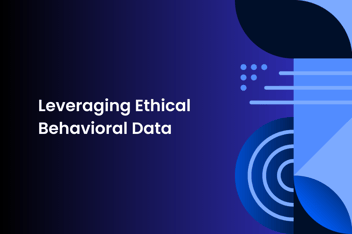Attitudes and insights shaping advertising effectiveness in 2025 and beyond
What drives consumers today won’t be the same tomorrow and the day after. Preferences are evolving rapidly, shaped by real-time social, political, and economic shifts, and brands that fail to adapt risk losing their relevance.
Especially as optimism grows in some areas and anxieties persist in others, advertisers and marketers face a critical question in 2025: Are their strategies keeping pace with the people they aim to reach? And if so, how effectively?
DISQO’s 2025 Consumer Trends report illuminates these shifting sentiments and behaviors, providing a clear roadmap for brands to stay relevant in a changing world.
From tapping into rising optimism to addressing economic challenges, political shifts, and emerging technologies, building a strong ad measurement foundation is no longer optional—it’s essential for crafting strategies that connect, resonate, and deliver tangible results.
1. Tapping into growing optimism
2. Navigating economic concerns
3. Adapting to a presidential transition
4. Cautiously employ AI innovations
Tap into growing optimism
As 2025 unfolds, rising consumer optimism opens the door for brands to engage audiences eager to embrace hope and ambition for the future. While sentiments slightly vary across demographics, Millennials (34%) and Black consumers (40%) are leading the charge in positivity about the year ahead.
As most consumers anticipate general improvements over the next five years, advertisers should embrace uplifting and forward-thinking campaigns with personalized messaging that aligns with consumers' aspirations.
Optimism signals a readiness to envision and invest in a better future, making it a powerful emotional driver. By understanding consumers' hopes and ambitions, brands can demonstrate empathy and align with their lifestyles and values, creating deeper emotional connections.
This positions brands not just as sellers but as trusted partners in the consumer journey—one that inspires and empowers. This approach fosters positive brand associations and strengthens loyalty, as consumers naturally gravitate toward brands that feel meaningful and aligned with their identity.
Segmentation and precision are critical because this rising tide of optimism isn't uniform. Advertisers should leverage cross-channel measurement to identify and engage with audiences who have a hopeful outlook. Tapping into optimism through inspiring storytelling or relatable solutions can help brands stand out and build meaningful connections in the year ahead.
Navigate economic concerns
While optimism about the future is growing, economic anxieties persist. Inflation, potential recessions, and geopolitical tensions remain top-of-mind for many consumers, influencing how they spend and engage with brands. This behavior is a reminder that economic uncertainty continues to shape consumer preferences.

Advertisers should address these concerns by emphasizing affordability, convenience, and stability in their messaging and offerings. Highlighting value—through transparent pricing, flexible payment options, or seamless checkout experiences—reassures consumers wary of financial uncertainty.
Beyond transactional solutions, brands should nurture relationships by recognizing where their customers are in their financial and purchase journeys and tailoring messaging to reflect empathy and support.
Every touchpoint matters to build long-term trust, especially during economic uncertainty. From reassuring ads to seamless shopping experiences, brands can position themselves as reliable partners by emphasizing affordability and stability, measuring impact, and optimizing efforts every step of the way.
Adapt to a presidential transition and term ahead
A presidential transition often brings shifts in sentiment, and 2025 is no exception. While consumer sentiment and spending plans remain relatively stable, demographic divides paint a more nuanced picture. 38% of consumers expressed positive feelings about the effect of a Trump presidency on the economy and their finances, 37% feel negative, and 20% remain neutral.
These splits highlight the need for marketers to approach messaging with precision and care. Advertisers should use demographic insights to guide targeted campaigns, measuring ads early and often to ensure messaging resonates with specific concerns and aspirations. For some, this might mean emphasizing hope and opportunity; for others, it could involve acknowledging uncertainty while offering stability through reliable products and services.
Potential economic ripple effects, such as universal tariffs on imported goods, could also lead to price increases, adding to these challenges. Marketers must stay vigilant, balancing empathetic messaging with practical solutions that address affordability and value. By listening to consumer sentiment and adapting to changes, brands can remain relevant and trusted during politically charged times.
Cautiously employ AI innovations
Now past the peak of inflated hype and expectations, AI is more quietly reshaping how brands connect with consumers, creating opportunities to drive efficiency, personalization, and convenience.
While many consumers aren’t actively focusing on AI, its behind-the-scenes role in streamlining experiences is growing. Marketers should approach AI integration carefully, ensuring its use feels natural and transparent—enhancing customer journeys rather than overshadowing them.
Generational differences offer important context. Younger audiences often welcome AI for its convenience and innovation, while older consumers are skeptical of the technology and may value a more human-centric approach. These distinctions underscore the need to align AI-driven strategies with audience expectations, creating experiences that resonate authentically across demographics.
Success with AI starts small. By testing targeted applications—like predictive analytics or personalized content—brands can uncover meaningful ways to improve engagement and efficiency. When implemented thoughtfully, AI can amplify impact while reinforcing trust with consumers.
Measure what matters in 2025
The future belongs to brands that adapt to changing consumer preferences—and a strong measurement foundation is the key to staying relevant. DISQO’s 2025 Consumer Trends report delivers insights to understand and capitalize on shifting optimism, economic concerns, and opportunities for innovation.





